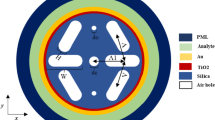Abstract
Early cancer diagnosis in molecular level shows great promise in relevant prevention and clinical treatment. Herein, we developed a novel method to detect and evaluate biomarkers on cancer cell surface. Based on the excellent selectivity of AS1411 aptamer to targeted nucleolin-overexpressed cells, we used a fluorescent probe with a pH-sensitive function to label the AS1411 aptamer modified with azide by click-reaction. The spectral characteristics of fluorophore naphthalimide has a good pH dependence. By this way, nucleolin-overexpressed cell could be discriminated from normal cell. Further, this strategy could also discriminate the breast cancer tissue from the adjacent benign tissue in formalin-fixed and parrffin- embedded (FFPE) tissue specimens. It is considered that our method has the potential to be applied in medical detection.
Similar content being viewed by others
References
Tan W H, Donovan M J, Jiang J H. Aptamers from cell-based selection for bioanalytical applications [J]. Chem Rev, 2013, 113(4): 2842–2862.
Arya S K, Bhansali S. Lung cancer and its early detection using biomarker-based biosensors [J]. Chem Rev, 2011, 111(11): 6783–6809.
Soontornworajit B, Wang Y. Nucleic acid aptamers for clinical diagnosis: Cell detection and molecular imaging [J]. Anal Bioanal Chem, 2011, 399(4): 1591–1599.
Liu J W, Cao Z H, Lu Y. Functional nucleic acid sensors [J]. Chem Rev, 2009, 109(5): 1948–1998.
Tavitian B, Terrazzino S, Kuhnast B, et al. In vivo imaging of oligonucleotides with positron emission tomography [J]. Nat Med, 1998, 4(4): 467–471.
Zhao W A, Schafer S, Choi J, et al. Cell-surface sensors for real-time probing of cellular environments [J]. Nat Nanotechnol, 2011, 6(8): 524–531.
Liang H, Zhang X B, Lü Y F, et al. Functional DNA-containing nanomaterials: Cellular applications in biosensing, imaging, and targeted therapy [J]. Acc Chem Res, 2014, 47(6): 1891–1901.
Wang J, Wei T, Li X Y, et al. Near-infrared-light-mediated imaging of latent fingerprints based on molecular recognition [J]. Angew Chem Int Ed, 2014, 53(6): 1616–1620.
Madshus I H. Regulation of intracellular pH in eukaryotic cells [J]. Biochem J, 1988, 250(1):1–8.
Schnatz P F, Castell J A, Castell D O. Pulmonary symptoms associated with gastroesophageal reflux: Use of ambulatory pH monitoring to diagnose and to direct therapy [J]. Am J Gastroenterol, 1996, 91(91): 1715–1718.
Li M, Guo Z Q, Zhu W H, et al. Redox-activated fluorescence switch based on a ferrocene-fluorophore-boronic ester conjugate [J]. Chem Commun, 2015, 51(7): 1293–1296.
Kim H M, Cho B R. Two-photon probes for intracellular free metal ions, acidic vesicles, and lipid rafts in live tissues [J]. Acc Chem Res, 2009, 42(7): 863–872.
Ko S K, Chen X, Yoon J, et al. Zebrafish as a good vertebrate model for molecular imaging using fluorescent probes [J]. Chem Soc Rev, 2011, 40(5): 2120–2130.
Bates P J, Laber D A, Miller D M, et al. Discovery and development of the G-rich oligonucleotide AS1411 as a novel treatment for cancer [J]. Exp Mol Pathol, 2009, 86(3): 151–164.
Author information
Authors and Affiliations
Corresponding author
Additional information
Foundation item: Supported by the National Program on Key Basic Research Project (973 Program) (2012CB720600, 2012CB720603, 2012CB720605), the National Natural Science Foundation of China (21432008, 91413109, 81373256, 91213302)
Biography: ZHOU Yan, female, Associate chief technician, research direction: tumor detection.
These authors contribute equally to this work
Rights and permissions
About this article
Cite this article
Zhou, Y., Fu, B. & Xiao, H. A pH-activatable fluorescent aptamer probe for imaging of target cancer cells. Wuhan Univ. J. Nat. Sci. 22, 247–251 (2017). https://doi.org/10.1007/s11859-017-1242-5
Received:
Published:
Issue Date:
DOI: https://doi.org/10.1007/s11859-017-1242-5




